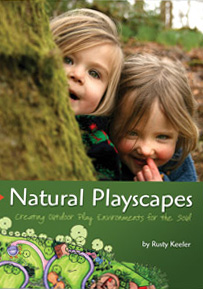ExchangeEveryDay Past Issues
 << Previous Issue
| View Past Issues | | Next Issue >>
<< Previous Issue
| View Past Issues | | Next Issue >> -Martin Luther King, Jr.
For our last trip down memory lane, I would like to share one of my favorite stories of the 3,390 issues of ExchangeEveryDay - the January 18, 2013 issue:
"When I was in Singapore last year to attend the Global Leaders meeting, I had the great pleasure of visiting the exciting classrooms of Bonnie's friend, Vashima Goyal. During the visit she told me about the exciting ideas of Jinan, a radical educator working with village communities in India on nature-based programs aimed at recovering authenticity, originality in terms of aesthetic sensibility, and cognitive process.
Vashima recently forwarded the video, Children Being in the World, which gives you a window into her thinking. Be sure to watch the 'outtake' after the credits."
|
Natural Playscapes |
|
Natural Playscapes: Creating Outdoor Play Environments for the Soul |





Comments (3)
Displaying All 3 CommentsAor International
Dallas, TX, United States
My kindergarten classroom, back in the '80's, was set up as a lab of inquiry, and we had one hour of worktime, where children made a verbal plan in a small group, and then went off to execute their plan, or change their plan, with their fellow students and the adults were there to support the children's activities. Then the children returned to their small groups to review & recall what happened. This is the core component of the Hig/Scope curriculum called plan-do-review. The brainchild of David Weikart, the High/Scope curriculum, when implemented appropriately, being child-centered, adult-supported, can be a very effective and balanced way to allow children to unfold naturally. Children, parents and staff are all included and respected. America would be well to adopt it as a national curriculum.
Creativity in Learning
Cumberland, Maine, United States
I'm so interested in the way our "educational" culture in the U.S. fears risk in learning--physical and emotional--we seem to do this to avoid potential litigation (http://www.educationworld.com/a_admin/admin/admin371.shtml). In the process, we remove, over and over again, opportunities for children to engage in active inquiry, learning and "knowing"--which often leaves them to sit in front of TV or computer screens.
I watched this film some time ago, and was so struck then as I am watching it again this morning, by the risk allowed in this film. We see the children on one side of the lens; we rarely see the adults. I want to know from the adults why (and how) their culture values risk as a learning tool. And I want to know more about the tipping point--that period of time in the U.S.--that moved us to a culture of fear. What happened?
United States
wow....thanks for this one.
Post a Comment